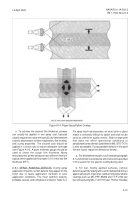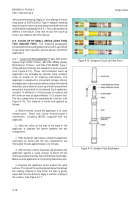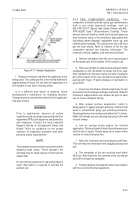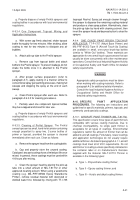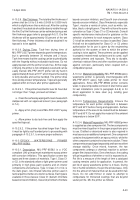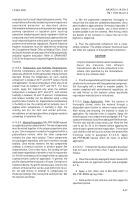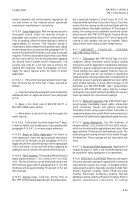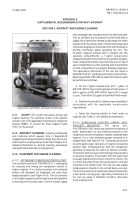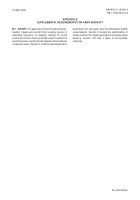TM-1-1500-344-23-2 - Page 195 of 240
A-25
NAVAIR 01-1A-509-2
TM 1-1500-344-23-2
15 April 2009
Class N shall not be substituted for Class C unless
authorization for its use is given by the engineering
authority for the system or item to which the primer
coating is to be applied. These primers can be applied
to properly treated metal surfaces and to cured, scuff
sanded primers and topcoats. They dry to flexible,
chemical resistant films and are usually coupled with
MIL-PRF-85285 Polyurethane Topcoat.
A-10.4.2. Temperature Requirements. Ensure the
temperature for each primer component is between
60
°
F and 90
°
F before mixing and application. Surface
temperature of the area to be coated must be between
60
°
F and 90
°
F. Do not apply this material if the ambient
temperature is below 60
°
F.
A-10.4.3. Material Preparation. TT-P-2760 primer is
supplied as a two component kit. The two components
must be mixed together in the proper proportions prior
to use. One component contains the pigment within a
vehicle, while the other component contains the clear
resin solution. These components are packaged
separately and have excellent storage stability. Once
mixed, however, the two components undergo a
chemical reaction to achieve proper film characteristics.
Over a few hours, the coating will gel regardless of
whether or not it is exposed to air. Pot life is a measure
of the length of time a catalyzed coating remains useful
for application. In general, the pot life of this primer is 4
hours. During hot or humid conditions, the pot life will
decrease. Only mix the amount of material that can be
used within two hours. Do not add thinner to attempt to
compensate for thickened coatings that are beyond
useful pot life. Mix the primer as follows:
a. Following manufacturer’s instructions, mix the
pigmented component as necessary to ensure that
solids are completely dispersed. If using a paint shaker,
agitate the material for approximately 10 minutes. If a
paint shaker is not available, use a clean metal or
wooden paddle to stir the contents. After mixing, check
the bottom of the container to ensure that all solids are
dispersed.
b. Pour the pigmented component into a clean,
empty container. The empty container must be at least
two times the capacity of the pigmented component.
CAUTION
Only mix materials from the same manufacturer.
Never mix materials from different
manufacturers. Mix the two components in the
volume ratio specified by the manufacturer.
Refer to the container label.
c. Pour the required amount of clear resin component
slowly into the container with the pigmented component.
Stir thoroughly with a metal or wooden paddle. To
remain compliant with environmental regulations, do
not add thinner to this material unless specifically
required per manufacturer’s instructions.
A-10.4.4. Spray Application. After the primer is mixed
per manufacturer’s instructions, strain the material
through a disposable paint strainer to remove coarse
particles. No induction time is necessary prior to spraying
this primer. Spray the mixed primer in one wet cross
coat in accordance with paragraph A-8.
A-10.4.5. Brush or Roller Application. For brush or
roller application, strain the primer and apply it uniformly
to the surface in one coat (refer to paragraph A-8.5).
A-10.4.6. Film Thickness. The total dry film thickness of
primer shall be 1.5 to 2.0 mils (0.0015 to 0.0020 inch).
After the coating has dried, the substrate will not be
visible through the film. Dry film thickness can be
estimated using a wet film thickness gage (refer to
paragraph A-5.7). Dry film thickness will be
approximately 50 percent of the wet film thickness.
A-10.4.7. Drying Time. Tack-free drying time of
TT-P-2760 primer depends upon temperature and
humidity, but will generally be within 5 hours. Tack-free
means that the coating can be touched lightly with the
fingertip without noticeable tackiness. Do not apply
topcoat until the primer is tack-free. TT-P-2760 primer
will be dry hard in approximately 8 hours at 70
°
F, which
means the coating is fairly durable and can be handled.
The primer dries more slowly at lower temperatures.
Topcoat is generally applied between primer tack-free
time and 24 hours after primer application.
Back to Top

